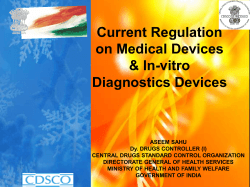
Flash report
flash INTEGRATED TESTING STRATEGIES 3Rs IN ANIMAL TESTING TIERED APPROACHES EUROPEAN PARTNERSHIP FOR ALTERNATIVE APPROACHES TO ANIMAL TESTING EPAA IN VIVO TESTING EUROPEAN COMMISSION INDUSTRY REDUCTION REFINEMENT REPLACEMENT OF ANIMAL TESTING PHARMACEUTICAL CHEMICAL COMMITMENT COSMETICS SOAP AND DETERGENTS ANIMAL HEALTH CROP PROTECTION LLNA RABIESANIMAL TESTS IN VITRO TESTING LRI-Cosmetics EuropeSTRATEGIES Joint Workshop INEPAA-Cefic SILICO MODELLING INTEGRATED TESTING 3Rs IN ANIMAL TESTING TIERED APPROACHES EUROPEAN PARTNERSHIP FOR ALTERNATIVE APPROACHES TO ANIMAL TESTING EPAA IN VIVO DTAP TESTING EUROPEAN COMMISSION INDUSTRY VACCINES REDUCTION REFINEMENT REPLACEMENT OF ANIMAL TESTING PHARMACEUTICAL CHEMICAL COMMITMENT COSMETICS SOAP AND DETERGENTS CONSISTENCY APPROACH ANIMAL HEALTH CROP PROTECTION LLNA RABIES ANIMAL TESTS IN VITRO TESTING IN SILICO MODELLING INTEGRATED TESTING STRATEGIES 3Rs IN ANIMAL TESTING TIERED APPROACHES EUROPEAN PARTNERSHIP FOR ALTERNATIVE APPROACHES TO ANIMAL TESTING EPAA IN VIVO TESTING EUROPEAN COMMISSION & INDUSTRY REDUCTION REFINEMENT REPLACEMENT OF ANIMAL th Helsinki, Finland, April 23-24 2015 TESTING INTEGRATED TESTING STRATEGIES 3Rs IN ANIMAL TESTING TIERED APPROACHES SKIN SENSITIZATION ALTERNATIVES Joint cross-sector workshop on Alternatives for Skin sensitization testing and assessment lines; a further method, addressing the third key event The next in a series of CEFIC-LRI/EPAA/Cosmetics Euof the AOP, dendritic cell activation, the human cell line rope workshops on skin sensitization was again hosted activation test (h-CLAT) has been validated by EURLin Helsinki by the European Chemicals Agency (ECHA) ECVAM and has a draft guideline under awaiting OECD on April 23rd/24th 2015. Approximately 60 participants, approval. Accordingly, it is essential for industry and the of whom the majority were from ECHA and EU member regulatory community to co-operate so that the prostate regulatory agencies, considered the issues assogress from validation, through acceptance to practical ciated with the use of non-animal test data in hazard use can be expedited. identification and classification, including for potency sub-categorisation. The overall objectives of the event On April 23rd, the workshop heard platform presenwere to undertake a critical assessment of how in vitro skin sensitisation data can be used in a tations from industry and regulators weight of evidence approach to enable detailing current status of in vitro ‘‘It is very likely that methods regarding the prediction of a defensible classification decision on a substance. In addition, key strengths in-vitro-based Inte- skin sensitization hazard, the potenand limitations, plus future needs were for sensitisation potency assessgrated Testing Stra- tial actively addressed. ment and approaches to the integrategies will at least ted assessment of data from multiple At the last workshop, just 2 years ago partially replace in methods. This material was given a it was noted that in “this area of toxipractical spin by the presentation of 6 vivo methods for cology, it is very likely that integrated individual case studies. These explored testing strategies (ITS) which are based individual substances, specific ITS/IATA skin sensitization on in vitro methods will at least partially approaches to testing and within just 2-3 years” (integrated replace in vivo methods for skin senassessment) strategies and the chalsitization within just 2-3 years”. That lenges faced by those undertaking probability is now a reality. The formal and/or reviewing the data. validation of two in vitro methods which address two key events in the adverse outcome pathway (AOP) for On April 24th, the second part of the workshop, three skin sensitization, i.e. protein reactivity and, keratinobreak-out groups addressed key questions, these being cyte activation have been translated into OECD Guidefollowed by an open workshop discussion. One focus PTO> The Workshop, hosted by ECHA, in Helsinki was on the question of how to integrate data from multiple assays, balancing harmonisation of approach for regulatory use with a need for some flexibility. The second group considered questions on the use of the methods for hazard identification, asking what level of uncertainty of prediction was acceptable. It was then noted that on current evidence, the prediction of skin sensitisation potential in humans appears to be more accurate from in vitro tests than from existing animal tests. However, it was recognised/concluded that, given the limitations and availability of the data, all of the information, including animal tests and studies of humans would need considered to establish the best predictor for humans. The third group extended this challenge to reflect on whether and to what extent the potency of an identified sensitiser could be predicted by in vitro methods. A key discussion point asked whether a sufficient body of human evidence exists to give reassurance that the predictions have merit? So what is still needed? First and foremost perhaps is that submissions must be adequately argued in the sense of providing a solid scientific foundation for decisions based on the outputs of these methods, taking into account any other contributions to the weight of evidence (the most obvious being knowledge from chemical structure). Particularly, where data is discordant, an adequate rationale to explain this must form part of the dossier. Helping to provide confidence for all will be clarity in the matters of applicability domains and any uncertainties associated with the assays and ‘‘None of the existing gathering and sharing experience of assays are perfect; their use. It has to be recognised that are not yet in a mature phase, the in vitro methods IATAs such that the workshop contained should not be expec- much active debate on several aspects. ted to be so either, but by the use of these methods, we have the opportunity to improve” The overall output from the break out groups coalesced into a few key points and recommendations. These can be summarised best by reflecting that we now have non-animal testing tools that represent the first three Key Events (KE) of the AOP. With two already having become official OECD Test Guidelines and a third enticingly close to that position (the Direct Peptide Reactivity Assay for KE1, Keratinosens for KE2 and h-CLAT for KE3), the switch from a primary requirement for LLNA data to a requirement for in vitro evidence is an imminent reality for those substances which fit within their applicability domain. ECHA is in the process of updating its guidance documents to reflect what registrants need to provide if data from combinations of these tests are to be used to meet regulatory requirements of the REACH Regulation. Nevertheless, there was broad consensus that a simple and transparent stepwise process involving the validated methods was an opportunity now waiting to be seized. There was also strong feeling that the approach should not be so rigidly defined that assay variations and alternative tests for the KEs were locked out, nor that it should preclude more complex IATAs being used within industries for their own purposes. Perhaps on a final note, all were reminded that the ultimate goal is a high level of protection of human health, and thus it will be the experience of people that will ultimately be the final arbiter of whether toxicological predictions are, or are not, correct. None of the existing assays are perfect; the in vitro methods should not be expected to be so either, but by use of these methods and all other relevant information, including clinical feedback, we have the opportunity to continue to improve. Participating Organisations\\\\\\\\\\\\\\\\\\\\\\\\\\\\\\\\\\\\\\\\\\\\\\\\\\\\\\\\ AirLiquide/SEPPIC BASF Beiersdorf British Health & Safety Executive BUAV/ECEAE CAAT EU Cefic LRI Chemical Watch Clariant Danish MSC member ECHA EPAA European Commission DG JRC/EURL ECVAM European Commission, DG ENV European Commission, DG GROW EVONIK/ CES Henkel HUMANE SOCIETY INTERNATIONAL KAO Corp. L’Oréal Merck KGaA OECD Polish Bureau for Chemical Substances - Department for Risk Assessment Procter & Gamble Rhodia / Solvay RIVM Romanian Chemical Department - National Environmental Protection Agency, Shiseido Symrise Panel Discussion About EPAA\\\\\\\\\\\\\\\\\\\\\\\\\\\\\\\\\\\\\\\\\\\\\\\\\\\\\\\\\\\\\\ EPAA is a Public-Private Partnership across seven industry sectors and between European Commission and Industry stakeholders. Launched in 2005, it gathers 36 companies, 7 European trade federations and 5 Directorates-General of the European Commission. About LRI\\\\\\\\\\\\\\\\\\\\\\\\\\\\\\\\\\\\\\\\\\\\\\\\\\\\\\\\\\\\\\\\\ Launched 15 years ago, the Long-Range Research Initiative (LRI) is one of the major voluntary initiatives of the European chemical industry to support its competitiveness and innovation potential. LRI aims to identify and fill gaps in our understanding of the hazards posed by chemicals and to improve the methods available for assessing the associated risks. LRI sponsors high quality research, published in peer-reviewed journals, and seeks to provide sound scientific advice on which industry and regulatory bodies will draw to respond more quickly and accurately to the public’s concerns. About Cosmetics Europe\\\\\\\\\\\\\\\\\\\\\\\\\\\\\\\\\\\\\\\\\\\\\\\\ Cosmetics Europe is the European trade association representing the interests of the cosmetics industry. Its membership consists of 27 national associations of the EU Member States and beyond, 16 major international companies, four supporting association members, four supporting corporate members and four correspondent members associated members. Cosmetics Europe represents more than 4,000 companies throughout the EU via the active representation of its member national associations. CONTACT entr-epaa@ec.europa.eu www.epaa.eu.com +32 (0)2 29 52 014 CONTACT man@cefic.be www.cefic-lri.org +32 (0)2 676 73 68 CONTACT KCondon@cosmeticseurope.eu www.cosmeticseurope.eu +32 2 227 6610
© Copyright 2025













